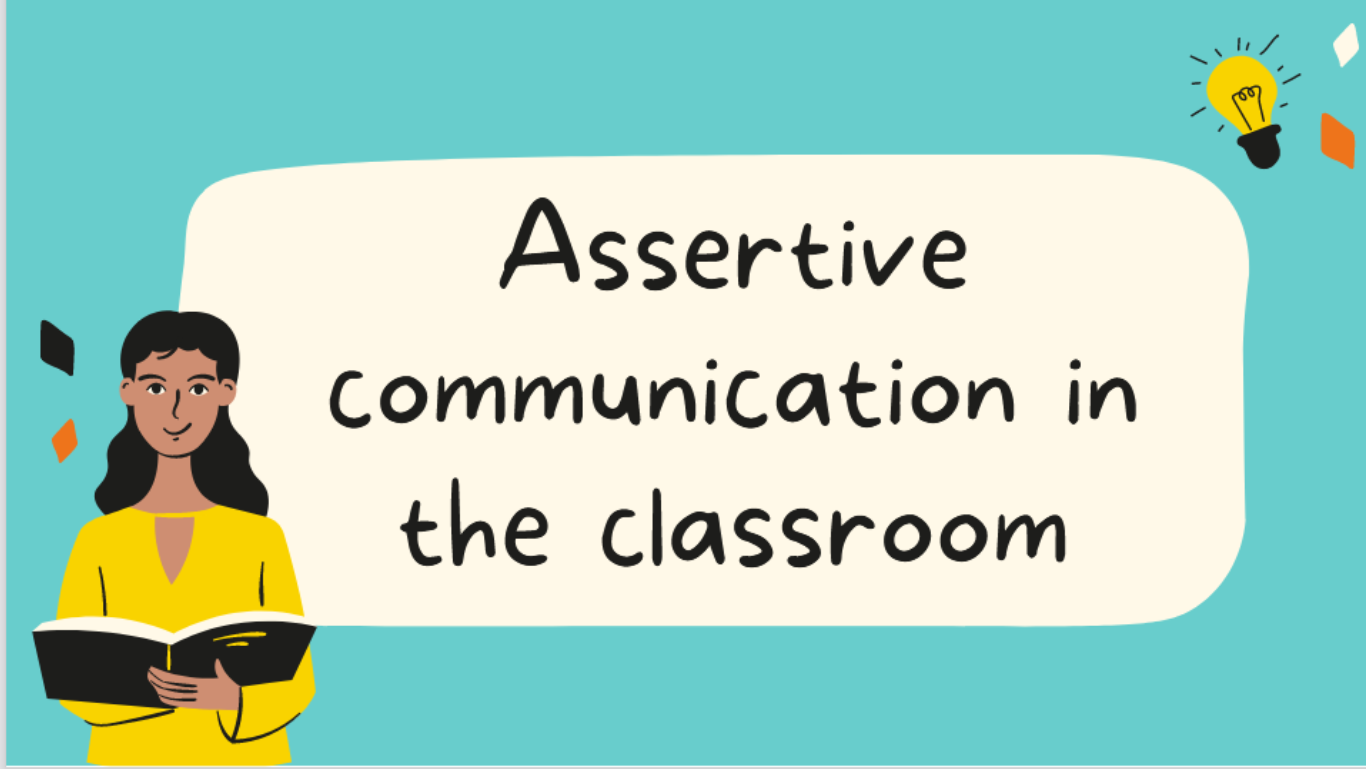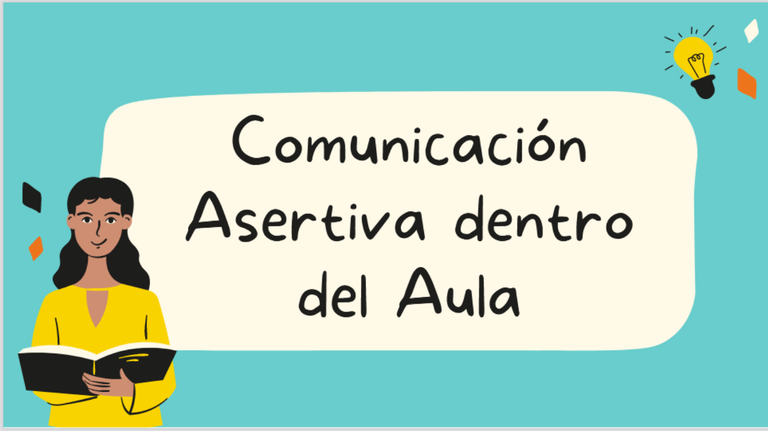
Image created en Canva
From my experience in the classroom, I have learned that to express ourselves assertively is to have the ability to express our thoughts and ideas in a clear, precise and honest way with the intention of making ourselves heard without being punitive or putting pressure on others. Seen in this way, this way of communicating seeks to resolve conflicts, put forward our arguments and try to seek the active participation of those involved in the communicative process and the improvement of a situation.
Before coming to this knowledge, I went through several situations as a counsellor and, later, as a consultant. In the first experience, I encountered a tutor who was rather cruel in his opinions and whom I decided to leave, only because he never finished telling me what my faults were. The second experience as a counsellor was not easy, because I had to deal with several student and professional egos that often made me look like the bad guy, just because I was not clear on how to make the other person understand their faults without being offended.

Now, how to deal with this whole issue of assertive communication in the classroom. Does this mean that the teacher must say yes to everything the students propose? Does it mean that the students are above academic opinions? Does it mean that I should give up my authority to become closer to the student? Well, no, by no means, the aim is for the students to be above the teacher and much less for the teacher to be above the student. The aim is for both parties to be able to reach a consensus in order to develop an appropriate class. Being forceful, firm and open to listen and talk to the other.
In particular, I have always believed that there is no such thing as a friendly relationship between a teacher and a student, mainly because of age and the role that both parties play in the classroom. One goes to school to learn, while the other goes to school to teach, so it's not about being friends, it's about getting along as well as possible in the classroom.
In this way, being assertive starts with expressing oneself clearly, without beating around the bush and without assuming that everything is clear. There can be no gaps in the communication process in the classroom. Allow yourself to listen to the other person or seek to get them to ask their questions and answer them until the doubts are cleared up.

At the same time, maintain a body language according to what we communicate, since we do not only use our words, we also use our bodies, so we must adapt it to the context. In other words, we cannot try to give them advice in a situation of indiscipline by laughing out loud, nor can we try to give them advice by shouting at them.
In this sense, empathy, respect and the opportunity to correct and be corrected are of vital importance in the training process, hence the importance of bringing them into the classroom and creating the necessary communicative situations that encourage the exchange of opinions in relation to a subject and to solve any problems that may arise in the future.
Many of the problems we have today are based on communication. People want to be heard, but they don't want to listen and this is leading us into a colossal abyss that every day leads to more wars, more violence, more lack of love and indifference. Let's find a way to get along better, even if we don't agree with each other, let's find, from our classrooms, a way to coexist with our differences, building bridges that lead us to a common place: life.
Esp

Imagen creada en Canva
Desde mi experiencia dentro del aula, he apendido que expresarse de forma asertiva es tener la capacidad de emitir nuestros pensamientos e ideas de forma clara, precisa, honesta con la intención de hacernos escuchar sin caer en actos punitivos ni de presión hacia el otro. Visto así, esta forma de comunicarnos busca resolver conflictos, plantear nuestros argumentos e intentar buscar la participación activa de los involucrados en el proceso comunicativo y las mejoras de una situación.
Antes de llegar a este conocimiento, pase por varias situaciones como asesorada y, posteriormente, como asesora. En la primera experiencia, me topé con un tutor bastante cruel al emitir sus opiniones y al que decidí dejar, sólo porque nunca terminó de decirme cuáles eran mis fallas. La segunda experiencia como asesora, no fue fácil, porque tuve que lidiar con varios egos estudiantiles y profesionales que muchas veces me hicieron quedar como la mala de la película, sólo porque no tenía bien claro cómo hacer para que el otro entendiera sus fallas sin ofenderse ¡Cosas que pasan!

Ahora bien, cómo lidiar con todo este tema de la comunicación asertiva dentro del aula. ¿Significa esto que el docente debe decir sí a todo lo que propongan los estudiantes? ¿Significa que los estudiantes están por encima de los pareceres académicos? Significa que debo dejar mi autoridad para volverme más cercano al estudiante? Pues no, de ninguna manera, se busca que el estudiantes esté por encima del docente y mucho menos que él esté por encima de él. Se busca que ambas partes sean capaces de llegar a consensos para lograr el desarrollo de una clase adecuada. Siendo contundentes, firmes y abiertos a escuchar y hablar al otro.
Particularmente, siempre he creído que no existe eso de la relación de amistad entre un profesor y un estudiante, principalmente, por el tema de la edad y por el rol que cumplen ambas partes dentro del aula. Uno va a la escuela a aprender, mientras que el otro, va a la escuela a enseñar, por tal razón, no se trata ser amigos, se trata de llevarse lo mejor posible dentro del aula.
De esta manera, ser asertivo partiría de expresarse claramente, sin rodeos y sin asumir que todo quedó claro. En el proceso de comunicación dentro del aula no pueden haber vacíos. Permitirse escuchar al otro o buscar que ellos hagan sus preguntas y responderlas hasta que se despejen las dudas.

Al mismo tiempo, mantener un lenguaje corporal acorde a lo que comunicamos, ya que no sólo usamos nuestras palabras, también usamos nuestros cuerpo, por lo que debemos adecuarlo al contexto. Es decir, no podemos intentar aconsejarlos frente a una situación de indisciplina, riéndonos a carcajadas, como tampoco, podemos intentar dar algún consejo gritándoles.
En este sentido, la empatía, el respeto, la oportunidad para corregir y ser corregido cobra vital importancia dentro del proceso de formación de allí la importancia de traerla al aula y crear situaciones comunicativas necesarias que propicien el intercamo de opinones en relación a algún tema y subsanar los problemas que pudieran presentarse a futuro.
Mucho de los problemas que tenemos actualmente tienen su base en la comunicación. Las personas quiere ser escuchadas, pero no quieren escuchar y eso nos está llevando hacia un abismo colosal que cada día nos lleva a más guerras, más violencia, más desamor e indiferencia. Busquemos la forma de llevarnos mejor, así no coincidamos con el otro, busquemos, desde nuestras aulas, la forma de convivir con nuestras diferencias tendiendo puentes que nos lleven a un lugar común: la vida.
@tipu curate 6
@tipu curate 4
Upvoted 👌 (Mana: 0/55) Liquid rewards.